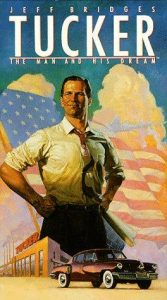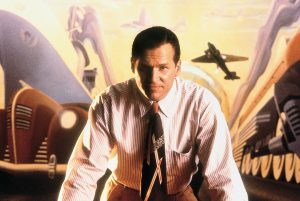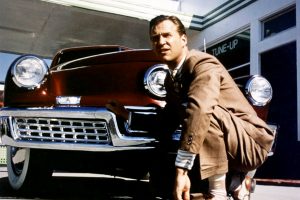
Tucker: The Man and His Dream
Okay, I’m not going to say that it’s more difficult to get my hands on a copy of the 1988 film, Tucker: The Man and His Dream than it is to get my hands on a real Tucker, but it’s pretty damn close. The technology-savvy partner and I scoured the Internet, looking even for a place to buy the electronic copy of the thing, but not only was it unavailable on iTunes, Amazon, and all the rest, the only conceivable way to find it was to buy someone’s used VHS tape for $60… Imagine that, we’re living in the age of immediate communication gratification and a VHS is going for $60.
 Of course, we didn’t buy the VHS. It turns out that Netflix has a copy, apparently the only copy, of the film in digital format, so we waited three to five days like savages in the age of Blockbuster until the red and white envelope came in the mail.
Of course, we didn’t buy the VHS. It turns out that Netflix has a copy, apparently the only copy, of the film in digital format, so we waited three to five days like savages in the age of Blockbuster until the red and white envelope came in the mail.
To give a little backstory on why I was so intent on finding this film, this week marks the 30th anniversary of its release, and I thought coverage would be an interesting look into the years that have passed, and the successes and failures of independent car companies, as well as the Big Three, in the time since Preston Tucker staked his heart against the motor world. Of course, naive as I was, I thought that I might actually be able to find the film. But alas.
The movie is, well it’s good, obviously. Directed by Francis Ford Coppola and starring the youngest Jeff Bridges I’ve ever seen, it has that mafia, backdoor dealing, unfettered behavior feel, mixed in with the small town life of Preston Tucker and co. and mired in joy and success and the eventually downfall of the company that should have been.
Though I’m familiar with the general goings-on of what happened, or rather, didn’t happen to the Tucker car company, the politics and business got a little heavy in the middle, and though I managed to keep my eyes open for the entire film, my partner was not so determined, I found that I didn’t quite understand the nuances behind each of the events.
That’s okay. In the end, since the story is, ultimately, based on history, the powerful companies beat out the little guy and Preston Tucker becomes a fascinating footnote in history, instead of the way of the future, like he most definitely could have been.
 And in that, I find it so interesting that this film is nowhere to be found.
And in that, I find it so interesting that this film is nowhere to be found.
If Tucker were operating in today’s day and age, like Elon Musk or Christian Von Koenigsegg, the story would have been different. For one, the Big Three have fallen time and again. His push against the standard practice of automaking was just one chink in the armor of what would eventually crack and crumble, first to Japanese and German imports, then to the gas crisis and manufacturing regulation, and again to the recent recession. Though they continue to get up, battered and bruised, they are no longer an impenetrable force of capitalism, greed and fear that they were when Tucker threw his rock.
And if anything, this film gives humanity to the little upstart that spooked the car industry. It takes the short run failure and turns it into something of a success, a harbinger of change– though, of course, in 1986 no one was to know just how much automotive change was really on the horizon. And both the film’s current rarity and near miss itself, for it should never have been made and flopped several times in production before George Lucas came about after nearly a decade, speak to some of that good old American grit and determination, and the ease with which the little guy can be erased from history.
Despite its rarity, Tucker: The Man and his Dream was nominated for several prestigious awards, including three Oscars for Best Actor in a Supporting Role (Martin Landau), Best Art Direction-Set Direction and Best Costume Design. Like the very theme of the story, it was declared a box office bomb, coming in at just over $19 million in sales, which didn’t even touch the $24 million for production.
So what’s the takeaway? Well, like the film and the man itself, the road is bumpy and filled with ups and downs. Of course, if you can find a copy–or perhaps you’re the one selling it for $60 on Amazon, then it’s worth a watch. After all, it’s the story of hope, brilliance and determination.
 More than that, however, this film, and the man it is based upon, are stepping stones in the car world. Without Tucker, and his fifty cars, without that upstart thinker who got the automotive world in a twist, we might not have our independent car producers of today. We might not have the ubiquitous Teslas on the road, or the success of so many small car companies with their training wheels still on.
More than that, however, this film, and the man it is based upon, are stepping stones in the car world. Without Tucker, and his fifty cars, without that upstart thinker who got the automotive world in a twist, we might not have our independent car producers of today. We might not have the ubiquitous Teslas on the road, or the success of so many small car companies with their training wheels still on.
The film, and the story behind it, are not a tale of failure or success, but rather, a tale of the changing of the times, and how nothing ever stays the same for long. And while Tucker did ultimately fail in his goals of creating the next great car company, there is something akin to hope in the idea that these times aren’t permanent, and that the next great car company could be out there on the horizon, just waiting for us–and this time, it might even get the chance that Preston Tucker never did. ![]()
Images selected from Paramount Pictures

